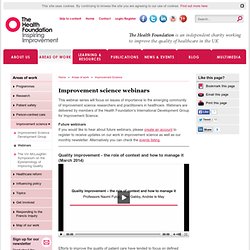

Experience based design guide. For Older Adults, Unexpected Hazards In Several Provisions Of The Affordable Care Act. June 21st, 2012 One of the goals of the Affordable Care Act (ACA) is to reduce the fragmentation of services for patients.

The problems of fragmentation are magnified for the six million Americans receiving long-term services. New analysis, released as a Web First by Health Affairs, examines the impact on this population of three provisions of the ACA—the Hospital Readmissions Reduction Program (Section 3025), the National Pilot Program on Payment Bundling (Section 3023), and the Community-Based Care Transitions Program (Section 3026). It finds that these provisions inadequately address the unique needs of Americans receiving long-term services, and, in some instances, produce unintended consequences that contribute to avoidable poor outcomes. Mary Naylor of the University Of Pennsylvania School of Nursing and coauthors selected these three provisions because each is designed to enhance transitional care and prevent avoidable poor outcomes among the Medicare population.
IHI Home Page. Making Change Happen, on a Deadline. Fixes looks at solutions to social problems and why they work. The PreFabricated Building Parts Production Enterprise in Addis Ababa is a state-owned company that makes concrete walls and other structures, mainly for the Ethiopian government’s low-cost housing program. Public-sector construction companies in the third world are not generally known for energy, flexibility, risk-taking or creative thinking. PreFabricated, in other words, does not seem like the kind of business that would or could do astonishing things in a hurry.
Like many companies in AIDS-wracked Ethiopia, PreFabricated had an AIDS policy, which included extra pay for its H.I.V. positive workers so they could buy more food. In March, 2008, the company decided to do more. This was a startling idea. Rapid Results InstituteRapid Results team members traveled to a village in Ghana, where they later built a school at half the typical cost and lowered student absenteeism from 49 percent to 16 percent. ICPC NCC. Rotator powered by <a href=" a free and easy <a href=" slider</a> builder from DWUser.com.
Please enable JavaScript to view. September 11, 2013: The Remington Report® September/October 2013 A Community-Based Approach To Improving Care Transitions And Reducing Hospital Readmissions: Updating The Evidence Reducing Readmits Through A Coalition Of Post-Acute Providers August 12, 2013: ICPC Aim Call/ESRD Collaboration Call Agenda Presentation Slides Additional Resources Call Recording July 30, 2013: Care Transitions National Event – Recording July 22, 2013: Care Transitions National Event - handout July 2013: Kitsap County Cross Continuum Care Transitions Project (KC4TP) Video February 2013: Care transitions work featured in Winter 2012-13 edition of Generations: Journal of the American Society on Aging, “How Did We Make Transitions Such a Big Deal?”
June 2012: Check out the conference materials from the second National Learning & Action Event held June 4-5 2012 in Washington, DC. Improvement science webinars. Efforts to improve the quality of patient care have tended to focus on defined technical interventions, often with mixed results in different settings.

There is increasing recognition that it’s not just what you do, but the way that you do it and the environment or context that really matters. A range of factors can affect the success of improvement, from the external policy environment, to organisational culture, to local structures, available people and processes. This webinar – with Naomi Fulop, John Gabbay and Andrée le May, chaired by Bill Lucas – explores why context needs to be taken into consideration when attempting improvement, and what skills best help professionals to manage context effectively.
Program for Readability In Science & Medicine (PRISM) Program for Readability In Science & Medicine (PRISM) is a Group Health Research Institute initiative to improve the readability of consent forms and other print materials for health care research study participants.

PRISM began in 2005 as a short-term, internal training initiative called the “Project to Review and Improve Study Materials.” It has since evolved into a suite of plain language resources tailored for the research community. Inspired by health literacy concerns in the research environment, PRISM’s goal is to bring readability awareness and plain language training and tools to researchers nationwide. For both compliance and safety reasons, research teams should strive to ensure that all print materials used in communication with study participants are as easy to read as possible.
Most Institutional Review Boards (IRBs) recommend or require that study participant materials meet a reading level target of 6th to 8th grade. Download the PRISM Readability Toolkit (PDF, 888 KB). SQUIRE: Guidelines Home. Not Running a Hospital. For Partners in Healthcare.